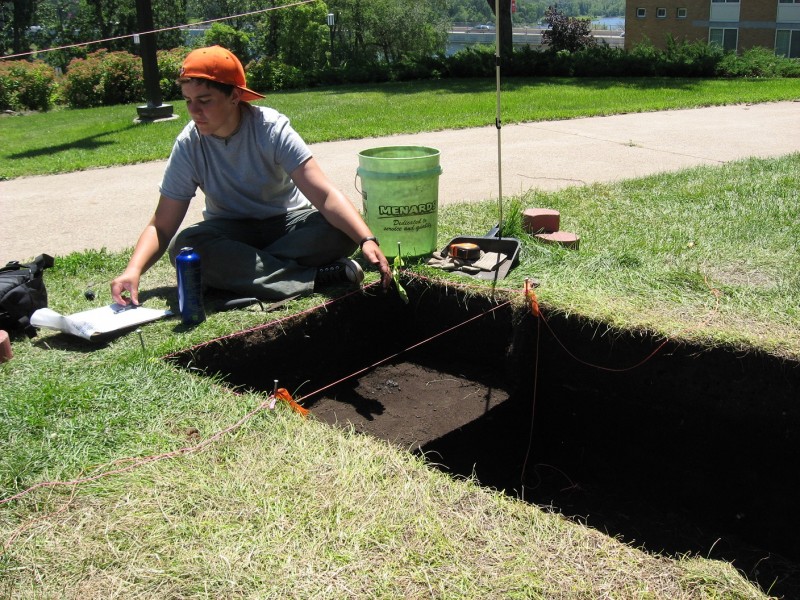Webinar: Archaeological and Interpretive Research at St. Clair’s Defeat and the Battle of Fort Recovery
Wednesday, December 13, 1:00 pm
We have a historical archaeology focus for December as we welcome Christine Thompson of Ball State University to discuss frontier Ohio in the 1790s. The Northwest Indian War battles St. Clair’s Defeat (1791) and Battle of Fort Recovery (1794) involved multiple Native Tribes and the U.S. military. Over 12 years of archaeological, preservation, and interpretive research at the battlefield has evolved into updated interpretation co-created with descendent Tribes. Chris will share a summary of this work, the funding awarded for these projects, and focus on two major interpretive products including an online walking tour/wayside exhibits, and a traveling exhibit St. Clair’s Defeat: A New View of the Conflict.
About our presenter:
Bio: Christine Thompson is the Assistant Director and Archaeologist at the Applied Anthropology Laboratories (AAL), Ball State University. Her research interests include the Late Archaic Glacial Kame culture, public archaeology, NAGPRA, and interpretation of historic battlefields. She works to fulfill the AAL mission of inspiring and preparing AAL student employees for the workforce by providing students hands-on learning opportunities through the fulfillment of grant awards and cultural resource management contracts. Thompson strives to build lasting partnerships with Federally Recognized Tribes, communities, museums, historical societies, and other groups while collaborating on funded research projects.

I dig history, do you?
When I started college, I initially went to school for historic preservation. I always wondered what it was like to live a century ago, loved looking at historic photographs and hearing stories from the older residents in my town. While in college, on a whim, I took two archaeology classes one semester and fell in love. Yes, history provides you with names and dates and beautiful stories; however archaeology appealed to me because it is void of any opinion when it comes to telling the story of the past. I could tell you that I eat yogurt and snack bars at work, and drink a lot of water. However, if you took a peak at my garbage can next to my desk, you would see many candy and cereal bar wrappers, a few yogurt containers, and a lot of tea bags. Does that mean I live solely on those foods? No, however, it does mean that when I’m at that location, that is what I tend to consume. Material culture (physical remains, artifacts) can tell us a lot about history, particularly the history which doesn’t have a written record. It can also confirm written record.
If you think about a historic site as a whole with a story to tell, the standing structures tell just part of the story. A house, for example, can tell a lot about both the people who built the structure, as well as the current function. However, the house has not been there since time began. The landscape and what is beneath the land also has a rich history. Perhaps the area was formerly a farm. You might find footprints of former buildings, construction materials, farming tools, or animal bones. If there was a building and it collapsed in on itself, it will look different than if it was taken apart piece by piece. The material that the building was constructed of will leave different evidence and could show a different history. It could also show a chronology on the site, and help with dating the site. Materials such as nails were manufactured in different ways during certain set dates. Local resources used for construction material can also help provide the earliest date. Perhaps limestone or granite was quarried and used for building foundations, but you know that that ceased in a certain year. That year can be used as a point of reference.
One of the most important data components in archaeology is where the artifacts were found relative to the surface and relative to other physical or material culture. As archaeologists slowly excavate, the story of the history of that 1-meter square comes to light. Perhaps you find a 1980 penny and some plastic toys on the top surface, and then the next layer below you find the remnants of a glass bottle you can assign a date to, and kitchen utensils and maybe a broken dish, and then a layer of charcoal and burned wood when you know there was a house fire on that site at a certain date. This would indicate an area of undisturbed soil. However, many times all of those artifacts are lying next to each other; the 1980 penny sitting right next to a wire nail from the 1890s. This isn’t necessarily a bad thing; it still provides us with a picture of site activity because it would indicate that at some point the ground was disturbed. Perhaps it because it became plowed field, perhaps a tornado ripped through, or maybe a road came through nearby and the soil was dumped there.
In the next year, I will be writing blogs about different archaeology projects that have occurred or are occurring in Ohio. I encourage you to think about what other history is below ground, or what questions could be answered/confirmed through archaeology.


